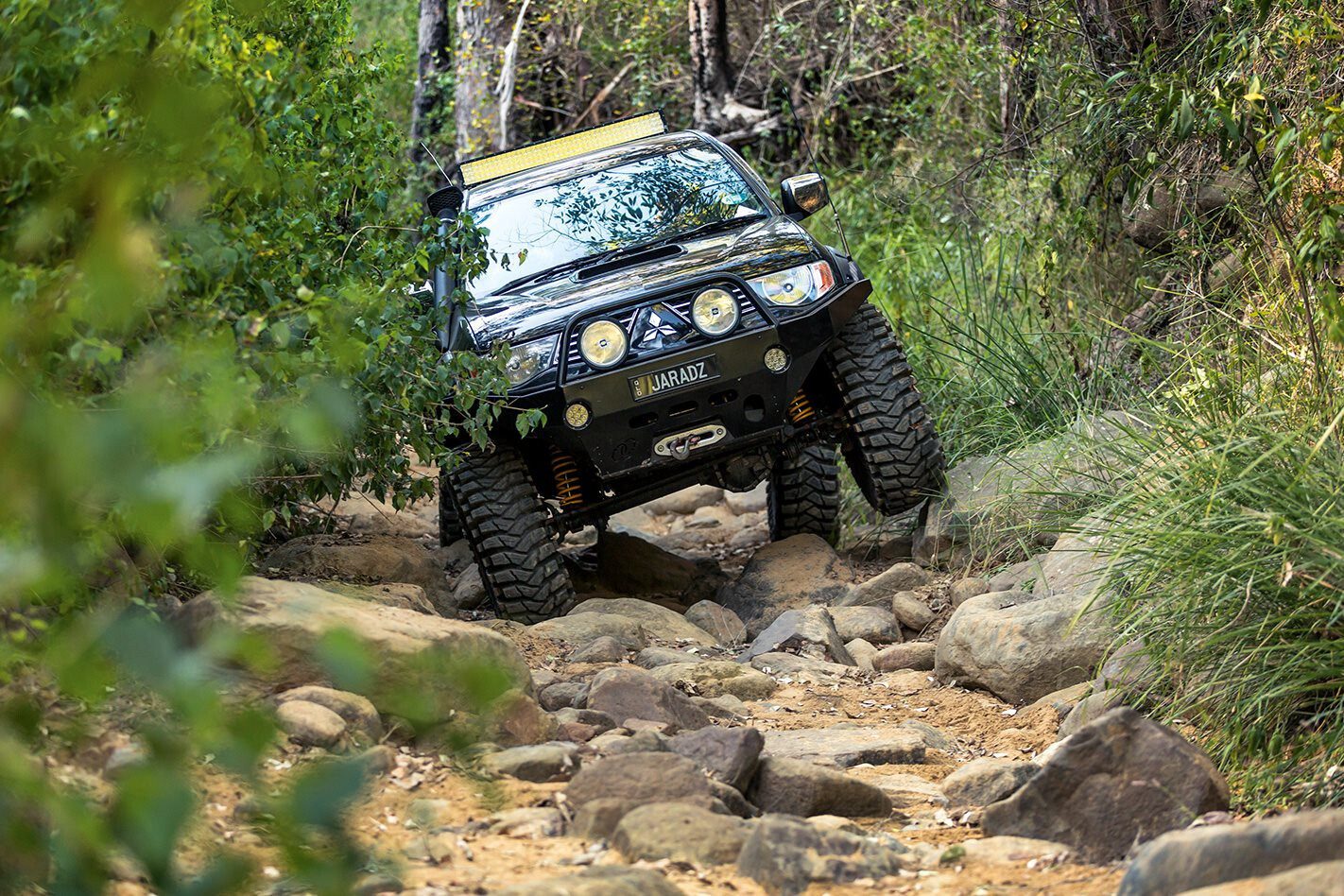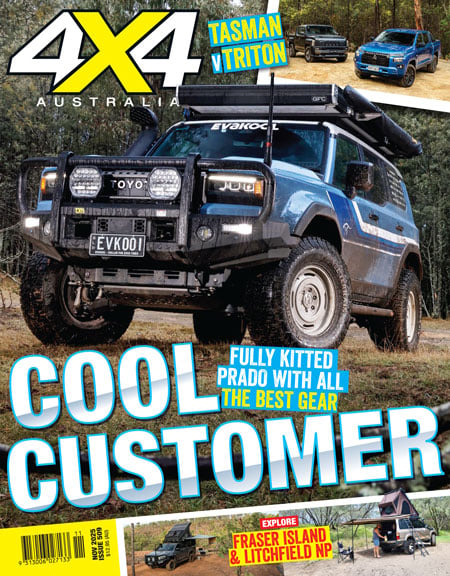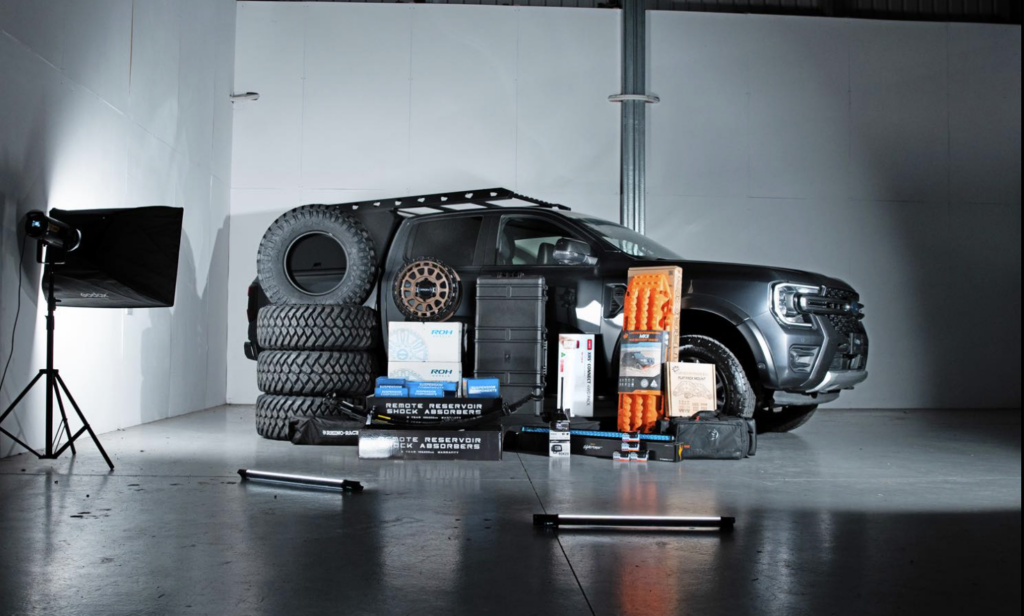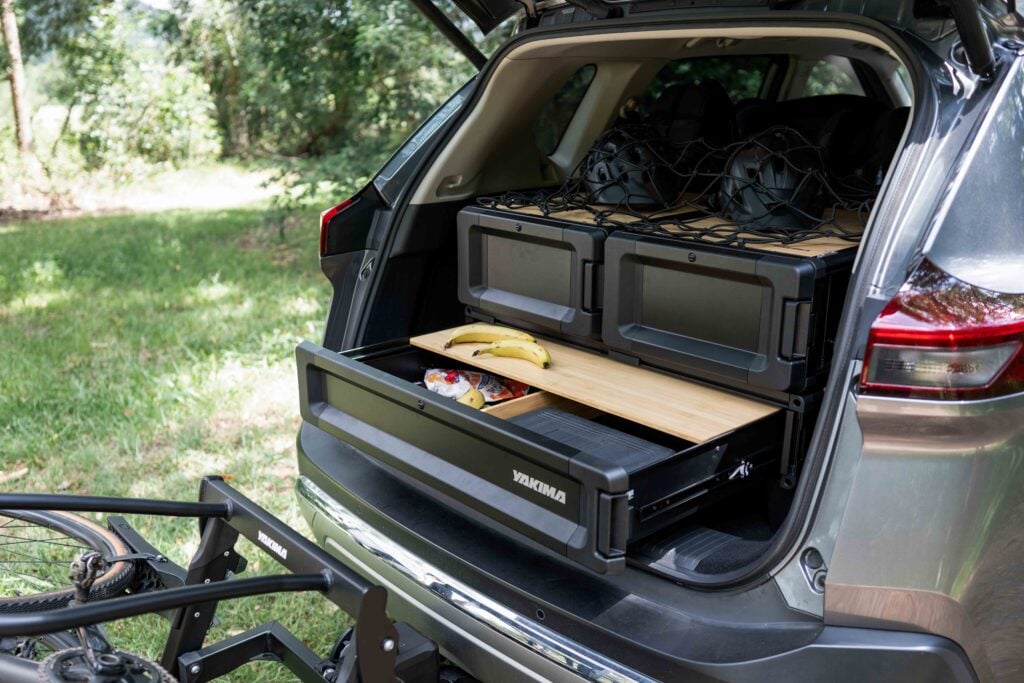THE live axle is the unquestionable off-road king.
It was in first place for decades before second place was even thought of and it earned that position due to its uncompromising strength, ease of maintenance and superior off-road ability. For some, they’re the defining factors for what makes a real 4×4.
Despite all this they’ve been dropping like flies from new car lineups.
If you’re in the market for a brand new 4×4 with a live axle up front, your choices are limited. The LandCruiser 70, Jeep Wrangler, GU Patrol and Land Rover Defender are the only factory options and they’ve stopped making both the Nissan and Land Rover, leaving buyers with even fewer choices.
Enter the live-axle swap. Previously the home of the competition truck crowd, live-axle swaps are gaining in popularity among newer vehicles, picking up where the factories dropped the ball. The idea is simple: get the 4×4 you know and love with all its modern reliability, then lose the independent front end and replace it with a live-axle to give you the best of both worlds.
But what’s involved in the process, how does it perform, how legal is it and how much is it going to hurt the back pocket? We’ve teamed up with Steve Etcell from Automotive Etcellence and Bud Dryden from Bud’s Customs to bring you everything you need to know.
THE BASICS THE introduction of independent front suspension in 4x4s was seen as a step forward by the road-going crowd and a giant leap backwards by remote-area travellers. While IFS drastically improved ride and handling it came at the cost of complexity, with the unintended side effect of less off-road ability due to lifted wheels. When one wheel is lifted on a live axle the weight of the 4×4 physically pushes the opposite wheel into the ground allowing it to continue gripping, whereas an IFS set-up will leave one wheel dangling – even if articulation is similar.
A live-axle conversion aims to fix both of these issues by physically replacing the complicated IFS set-up with a much simpler and stronger live axle.
The process in theory is simple: the vehicle is put on a hoist, the original suspension removed and the chassis rails ground clean. From here it’s as simple as either mounting leaf springs or a link and coil arrangement, depending on your goals. That’s the theory anyway, but as with most things in life the theory rarely touches on all aspects.
“Live-axle swaps involve precision bracketry, excellent welding and an in-depth understanding of the forces involved on individual components,” Steve stated. “The tricky bit is to sort out the steering and suspension geometry, as well as spring weights, so your vehicle doesn’t ride like a pig,” Buddy added.
While a leaf-spring conversion on older vehicles is essentially a paint-by-numbers affair, coil spring and link arrangements require painful fine tuning and a deep understanding of suspension geometry. If you’re performing the conversion yourself, a fine-tuned kit from an established supplier can reduce a lot of potential issues and be purchased for around $10,000. If you’re leaving it in the hands of the pros it can cost up to $20,000, depending on the upgrades chosen.
WHAT’S IN A NAME BEAM axles, live axles and solid axles are basically the same thing. The term live axle stems from the entire axle moving throughout the range of suspension travel.
Solid axle is in reference to the lack of control arms or additional components – the whole thing is more or less one solid chunk of steel. The term beam axle is because, well, they look like a beam.
OFF-ROAD ABILITY THERE’S a common misconception that lockers are a viable alternative to articulation. While both can achieve the goal of increased off-road ability, they each go about it in very different ways.
In fact, neither can reach their full potential without the other. Forward progression when off-road is most often halted by a loss of traction. Tyres can be to blame for this, but an unlocked axle sending drive to a lifted wheel is often the reason – a curse of an independent design. A locker will send equal drive to both wheels, allowing the wheel firmly on the ground to drive.
A suspension system with increased articulation can get around the same problem by keeping tyres on the ground longer. With both tyres planted firmly into the track there’s twice as much grip available. Steve raised the additional point of stability: “Lockers are great, but a wheel off the ground when in a big rut or rock step has to eventually come back down. This increases the risk of damage, loss of control and potentially having to push harder than the vehicle can or was built to.”
In an ideal world a vehicle would have both axles locked and a large, equal amount of articulation at both ends to ensure maximum grip and stability in every off-road situation. For most off-roaders, the ability of twin lockers and modern traction aids may be more than enough for their use.
For those pushing the capability of their vehicle, the increased articulation and physically stronger live axle can be an invaluable upgrade.
UPGRADE OPTIONS A LIVE-AXLE conversion is easily one of the most extreme modifications you can carry out on your 4×4, so it makes sense to do it right from the beginning.
Start with a clean slate – a disassembled (if not completely new) front axle and no existing mounts to conform to. This means that the only restrictions are your imagination and budget.
Steve and Bud both gave their insights into the upgrade paths often taken by their customers. “Generally, when a customer begins the process the main question we ask is what will you be using the vehicle for,” Steve told us. “The answer to that dictates the build. If it’s going to be used as a rock crawler rather than touring we’ll recommend a 3link [two lower links, one upper and a Panhard rod] with Johnny Joint rod ends, longtravel coil-overs and small, hard bumpstops.
If the vehicle is a remote tourer we’ll suggest a radius arm set-up with a spring and shock combo similar to a GU Patrol, as replacement parts are easier to source in the middle of nowhere.”
Bud added: “The conversion itself generally uses a front axle that is fabricated or simply taken from another vehicle. Invariably this results in mismatched diff ratios. If new diff gears are required there’s never a better time to fit a locker as it can be done at the same time for very little cost.”
Bud’s Customs favours coil-overs for their increased ride and suspension travel, but they’re often teamed up with a matching link and coil-over arrangement in the rear to further improve off-road ability and comfort – although, this can be done at a later date.
REAL-WORLD EXPERIENCES IT’S ALL well and good to throw money and parts at a 4×4, but it’s the results that matter. Recent improvements in shock and spring technology, combined with adjustable suspension links and tuneable sway-bars, means that ride and handling can be improved while suspension articulation can be dialled in to suit the driver’s needs perfectly.
Of course, this all pales in comparison to real-world experience, so we’ve enlisted the help of two owners of late-model, live axleconverted 4x4s to give their opinions. Ray Pisani is the owner of the pristine white Hilux on these pages, while Jarad Roberts is the owner of the tough-as-nails Triton featured in our July 2016 issue (page 64).
RAY PISANI “The first set-up was radius arms, and that handled just as good as IFS considering it was three inches taller on 35s. Seldom Seen Engineering did a good job setting it up as an all-round 4×4 as if it was done by Toyota. After a year or two I wanted more travel and that’s when Automotive Etcellence 3-linked the front. It’s a bit looser on-road but still drives well.
Off-road it flexes through the biggest ruts and sits so flat, a lot smoother than the radius arm set-up. If it was a dedicated tourer I’d run radius arms, but at the moment I’m having fun tackling the hard tracks and the 3link is perfect for that.”
JARAD ROBERTS “It’s a softer ride all around, but it does have a bit of body roll. The steering is a little heavier than it was originally, too. The front has a heavy spring rate, which helps keep it nice and stiff.
“Off-road it definitely shines. People get caught up with flex being the be all and end all, but having the strength in the front diff is the biggest advantage for me. I can run 37s and never worry about breakages, whereas with the IFS and 35s I was always snapping CV joints, even nursing it with custom-made, heavy-duty units.”
AVOID THE JUNKYARD THERE’S no skirting around the fact that a substantial reimagining of a 4×4’s suspension system isn’t exactly a cheap project. New springs and shocks, new suspension arms and new mounting points, so it’d be a borderline tragedy to then bolt a 30-year-old axle right in between it all. Thankfully the aftermarket is filled with brand new replacements from here or abroad.
If you’re aiming to keep your dollars in Australia, Bud’s Customs in Queensland and JMW Engineering in NSW both offer replacement fabricated housings. They’re built to order so can be made to spec for your application.
They can then be optioned up with other new components such as swivel hubs, spindles and diff centres. They’re often based on either Nissan Patrol or Toyota LandCruiser axles, making sourcing spare parts a simple exercise.
Alternatively, if you’re chasing a crate package, there are options available from the United States for complete units built to your spec from Dana-based axles. Dynatrac, Currie Enterprises and even Dana offer hub-to-hub axles with your choice of diff ratios, lockers, axles and armour. Off-the-shelf packages are available to run just about any wheel and tyre combination without the stress of component failure, although the price tag can be almost as high as the conversion itself.
SAFETY CONSIDERATIONS MODERN vehicles are appealing due to driver aids such as ABS, traction control, hill descent control and vehicle stability control. Despite their naysayers, these systems can make a 4×4 safer on- and off-road, and considerably more capable. Removing or bypassing these systems will make your 4×4 illegal, not to mention worse in almost every situation.
To get around this, workshops have gone to considerable lengths to retrofit newer safety systems to live axles. “A simple, reasonably priced conversion kit is available to restore ABS functionality to an LC80 axle when fi tted to late-model vehicles,” Bud said. “But this kit cannot be used in later vehicles with active ABS sensors that are also used for the stability control and traction control systems. We’ve recently developed a solution and have one on the road in an FJ Cruiser. We believe it’s a world first, which should also work in LC200s.”
LEGALLY SPEAKING DUE to our over-reaching and overcomplicated road laws, vehicles undergoing modifications like these must be certified differently depending on the state they’re being registered in.
This can cause some issues transferring vehicles between states, but it’s something that can be achieved.
While the paperwork and certification will be different in each state, the vehicle testing will be universal.
We spoke to Robert Elliot from VMC Engineering, who specialises in certifying extensive vehicle modifications, to find out the exact process to follow.
“People should always call a local engineer before they get started,” he said. “I’ve been to a few places and they’ve pretty much had to cut everything off and start again because they’ve got it slightly wrong.
“I’ll work with the owner as closely as they need me to, coming out after all existing brackets are cut off and guide them through where and how to make new mounts. Then I’ll come back once it’s all tacked in to check nothing will foul, the geometry is right and important components like sway bars are allowed for. When it’s all welded together we’ll road test it, then take it to a track for a day for a brake test and swerve test.”
The process generally costs around $2500-$3000, depending on how involved the engineer needs to be throughout.
However, it’s a vital component to ensure the vehicle is legal and safely built.
CONTACTS Automotive Etcellence W: www.autoetcellence.com.au Ph: (02) 8834 9711 Bud’s Customs W: www.budscustoms.com.au Ph: (07) 3133 1660 VMC Engineering W: www.vmcengineering.com Ph: 0403 328 574





